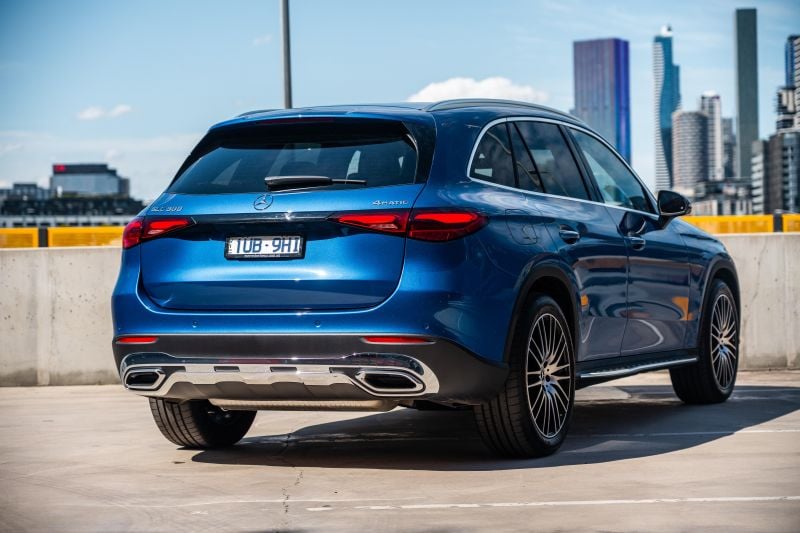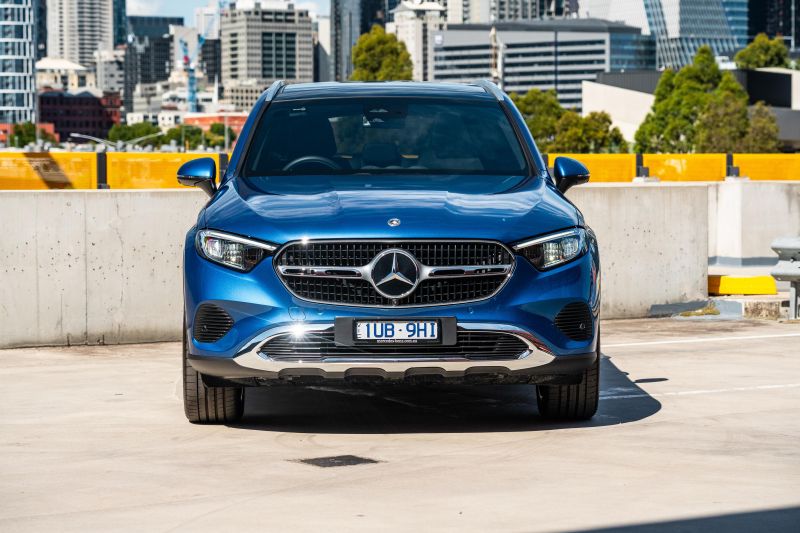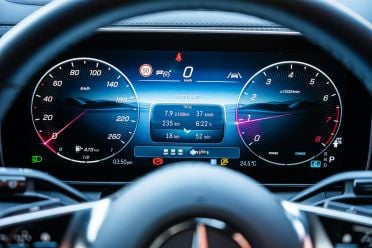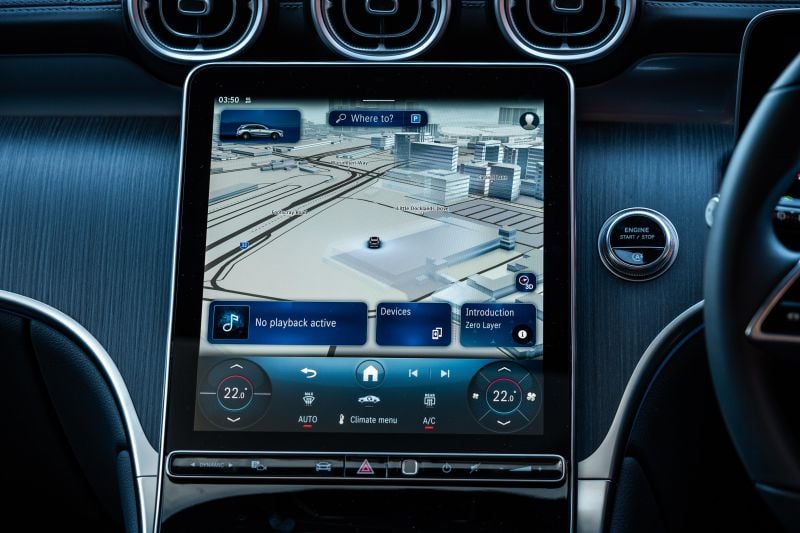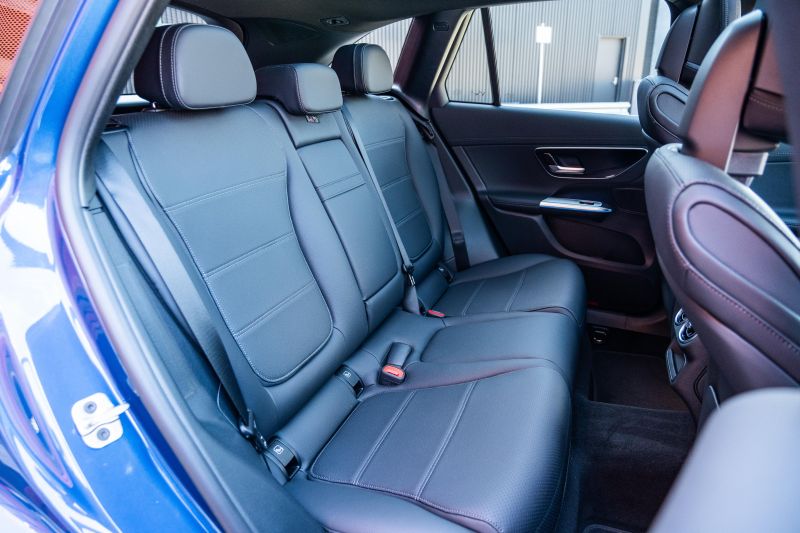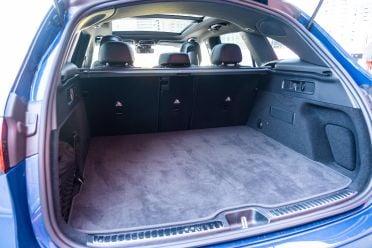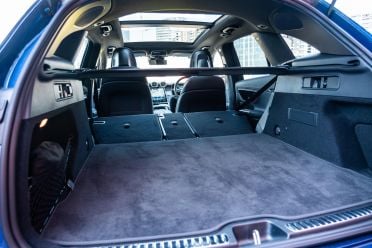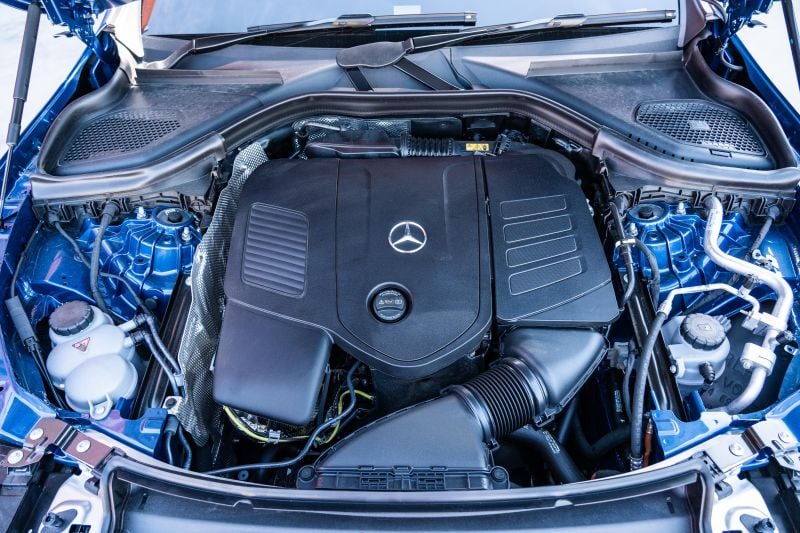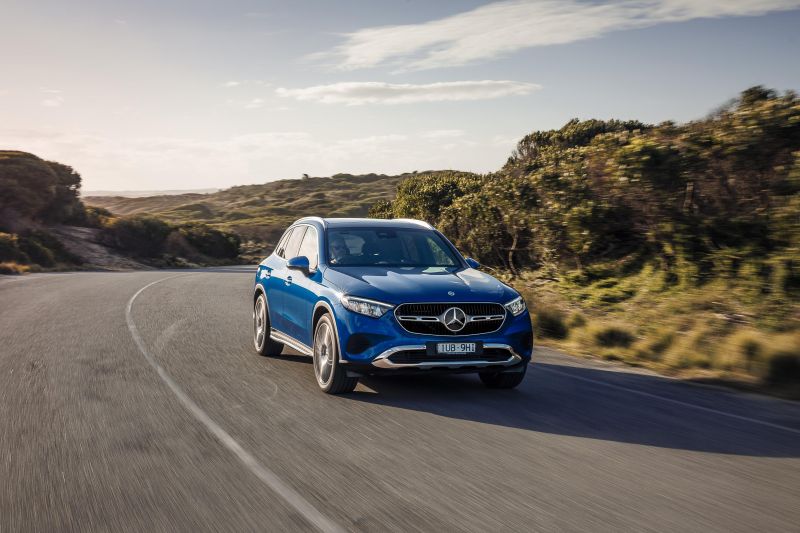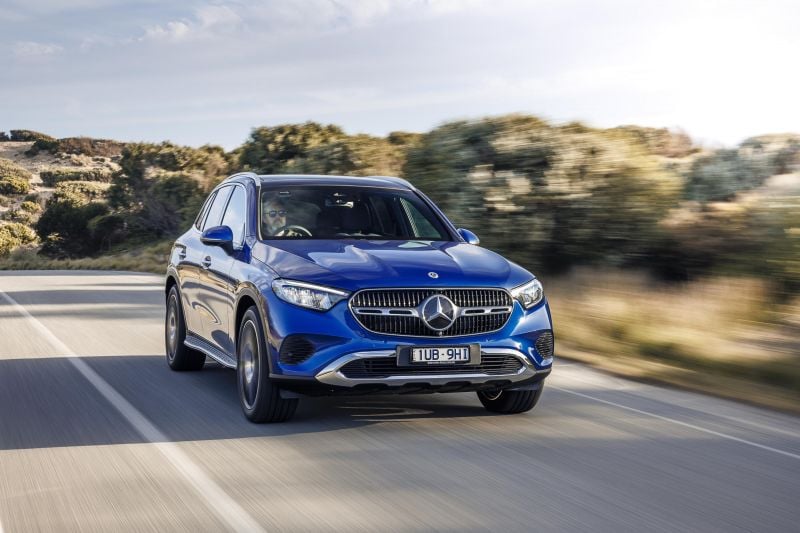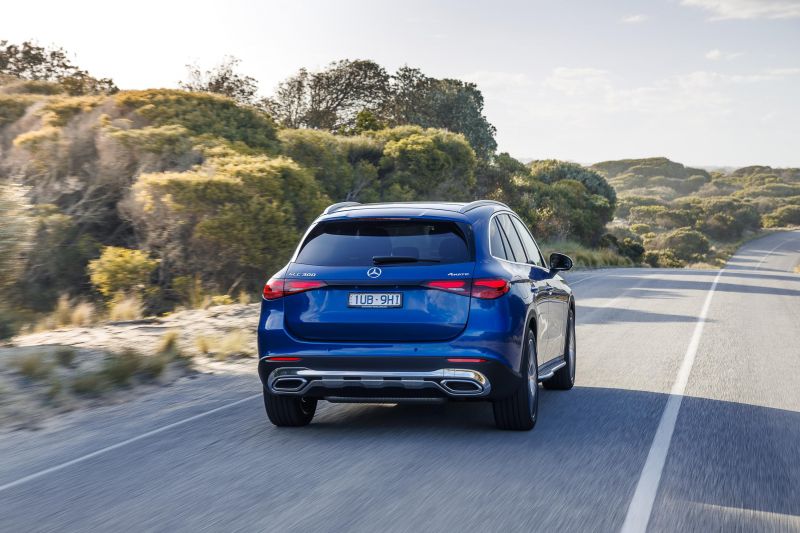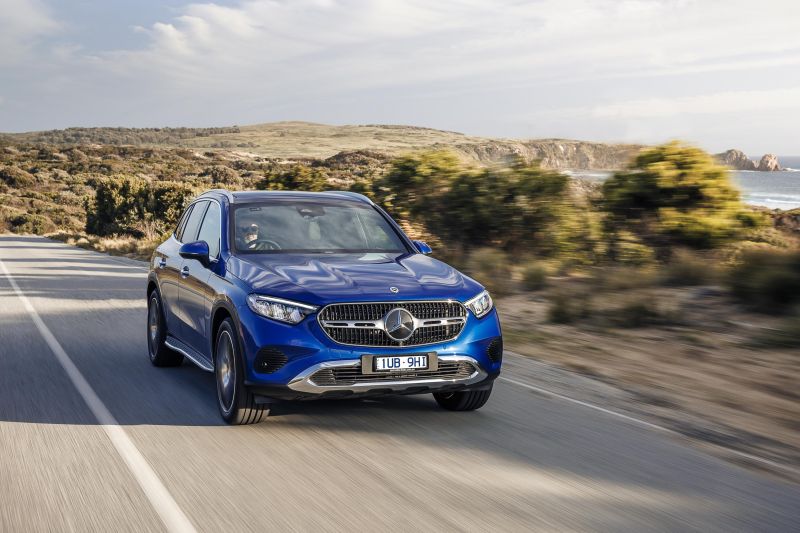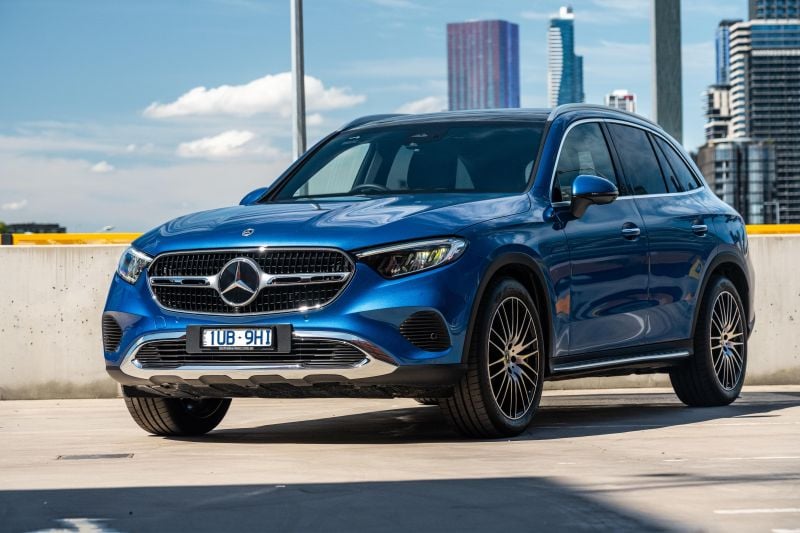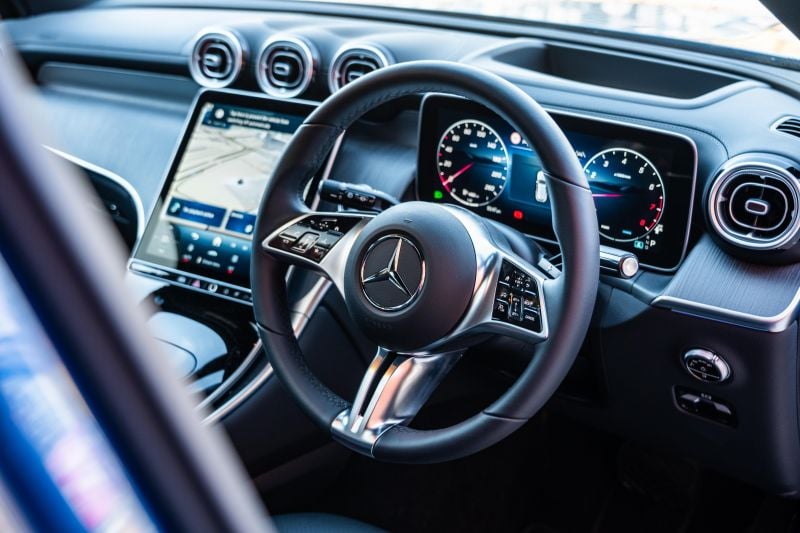The second-generation Mercedes-Benz GLC has been on sale in Australia for a couple of years now and, compared to the first-generation mid-size German luxury SUV, it still offers fewer options than the original.
Despite a wide array of powertrains available globally, including diesel and plug-in hybrid choices, Mercedes-Benz Australia opted to initially launch the new model with only the GLC300 4Matic, which is powered by a turbo-petrol engine with 48V mild-hybrid assistance.
The wagon body style launched first, followed by the polarising (yet surprisingly popular) ‘coupe’ version. High-performance Mercedes-AMG GLC43 4Matic and GLC63 S E Performance versions followed soon after.
Until recently, the GLC300 4Matic has only been offered with the AMG Line package, which is popular in Australia, but limits the amount of available configurations. This is where the GLC300 Avantgarde 4Matic comes in.
The arrival of the limited-edition variant marked the first time the Avantgarde styling package was offered in the second-generation GLC range. It ditches the sporty look and instead adopts more chrome and conventional SUV styling.
WATCH: Paul’s video review of the 2023 Mercedes-Benz GLC300 4Matic
On the outside there are gloss chrome finishes on the front grille, simulated skid plates front and rear, as well as 20-inch multi-twin-spoke alloy wheels in a bi-colour high-sheen finish.
Inside, there’s standard Nappa-look Artico leatherette upholstery, anthracite linestructure wood trim, high-gloss black highlights, a leather-wrapped multifunction sports steering wheel, velour floor mats, and Comfort front seats with four-way lumbar adjustment.
Since the GLC300 Avantgarde, the three-pointed star has launched the entry-level GLC200 4Matic, which also comes with the Avantgarde pack as standard, though the AMG Line pack is available as a no-cost option.
Is this the best version of the second-generation GLC yet? Read along to find out.
How does the Mercedes-Benz GLC-Class compare?
View a detailed breakdown of the Mercedes-Benz GLC-Class against similarly sized vehicles.

Mercedes-Benz
GLC
How much does the Mercedes-Benz GLC cost?
On test here is the limited-edition Mercedes-Benz GLC300 4Matic Avantgarde.
| Model | Price before on-road costs |
|---|---|
| Mercedes-Benz GLC200 4Matic | $89,000 $95,500 drive-away if ordered before April 30, 2025 |
| Mercedes-Benz GLC300 Avantgarde 4Matic | $99,990 drive-away while stocks last |
| Mercedes-Benz GLC300 4Matic | $105,100 |
| Mercedes-Benz GLC300 4Matic Coupe | $117,000 |
To see how the Mercedes-Benz GLC stacks up against its rivals, use our comparison tool
What is the Mercedes-Benz GLC like on the inside?
The GLC300 has a set of side steps that are a little pointless because this car isn’t lifted enough for you to need them. They impede ingress and can make your pants dirty if you graze your legs on them.
Once you’re in, you’ll see this car comes with the Avantgarde interior layout, rather than the sportier-looking AMG Line version. This means it has ‘Comfort’ seats, and a different-looking steering wheel, among other minor tweaks.
There are comfortable and supportive seats that are covered in Artico faux leather upholstery. Both the front seats offer oodles of adjustment as standard, including adjustable lumbar support, as well as seat base tilt and extension. All this means people of different sizes and statures will be able to find a comfortable seating position.
The front seats also offer heating, but not ventilation, which is a little disappointing in a $100k luxury SUV.
Ahead of the driver is the steering wheel, which feels nice in the hand and has buttery soft leather wrapping. It’s completely round and not flat-bottomed like the AMG Line steering wheel and is also not perforated.
Disappointingly, however, the steering wheel still features those annoying touch-sensitive buttons and sliders that can be fiddly to use. The panels are also covered in glossy piano black, so they attract fingerprints and look grimy quickly.
Behind this is a 12.3-inch digital instrument cluster, which is high-resolution and clear. You’re able to choose a number of different layouts and can also scroll through a range of informative pages. The Germans certainly do know how to make a good instrument cluster.
On top of the dashboard, there’s a large head-up display that can also display a variety of different views. Some have so much information that it can be overwhelming when driving. I preferred to opt for a more minimal view that showed just my current speed.
Moving across, there’s an 11.9-inch touchscreen infotainment system that’s virtually identical to those in a wide number of other Mercedes-Benz models. It has an almost square aspect ratio and is angled on the dashboard, rather than tacked on at the top like a big tablet.
The touchscreen itself is very responsive to touch inputs, and the user interface is easy to understand and navigate. It’s hard to get lost, and even if you do there’s always an easy way to get back to the home screen thanks to the prominent home icon.
As standard, there’s both wired and wireless Apple CarPlay and Android Auto connectivity, which is to be expected. With my iPhone 15 Pro Max connected wirelessly, I didn’t experience any major dropouts, though the connection did stutter over known interference points.
Like many cars now, you adjust the climate controls through the touchscreen infotainment system, which is a little annoying because it lacks the feedback that physical switchgear provides.
However, the lower portion of the touchscreen is permanently reserved for this, so it means it’s always readily available, even when using smartphone mirroring. It’s a good enough alternative that does make for a cleaner interior design.
Speaking of the interior design, there’s little to distinguish the GLC from the C-Class, E-Class, and arguably even electric models like the EQE and EQS. They all share similar open-pore wood dashboard panels with slanted touchscreen infotainment systems and a digital instrument cluster with no cowl.
It does look and feel premium, thanks to the large array of soft touches and metal finishes, but after jumping between a few Mercedes models, it means the GLC doesn’t feel special.
A major bugbear with current Mercedes-Benz interiors is the swathes of glossy piano black on major touchpoints. It’s on the steering wheel, the door cards, and even on the centre tunnel where the cupholders and wireless charger are. So fingerprints and smudges are almost unavoidable, and when you wipe them clean, the surfaces scratch easily.
It is nice having a large glass panoramic sunroof to give the interior some light, given that a lot of the finishes in this car are dark. You can also tilt and slide a portion of the glass roof for some added air in the cabin. However, if you get sick of the sun and close the blind, it doesn’t completely block-out and some light still creeps through.
In terms of first-row amenities, there are two cupholders (one of them is retractable), USB-C ports, as well as other incidental storage for bits and bobs. There’s also a centre console box with a USB-C port, a glovebox and door pockets that are decently sized. It’s all fairly standard.
The second-row bench seat is a fine place to sit too, but it doesn’t feel special either. There’s obviously more emphasis put on front-row occupants.
The rear seats are comfortable enough to sit on, and at a leggy 182cm I had enough space behind my own driving position. Overall, second-row space is on par for this segment, though more would be nice.
Second-row amenities are slim, but there are air vents mounted on the back of the centre console, and a fold-down armrest with cupholders. Interestingly, there are no USB-C ports in the second row, which is surprising given the family focus of this car.
Around the back, the power tailgate opens and closes swiftly, as it should. With the tailgate open, the boot space on offer is rather sizeable. There’s a claimed 620 litres of cargo capacity with the rear seats upright, which is very usable.
Amenities in the boot include tabs to fold the rear seats in a 40:20:40 configuration, bag hooks, a light, as well as a netted section off to the left.
Under the boot floor, there’s surprisingly a space-saver spare wheel, which is incredibly rare in mild-hybrids. Although it’s not quite as handy as a full-size wheel, having a space-saver still means you’ll be able to limp home if you experience a puncture.
| Dimensions | Mercedes-Benz GLC300 Avantgarde |
|---|---|
| Length | 4722mm |
| Width | 1890mm |
| Height | 1634mm |
| Wheelbase | 2888mm |
| Cargo capacity | 620L (5 seats) 1680L (2 seats) |
To see how the Mercedes-Benz GLC stacks up against its rivals, use our comparison tool
What’s under the bonnet?
The GLC300 Avantgarde is powered by a 2.0-litre four-cylinder turbo-petrol engine that’s augmented with 48V mild-hybrid electric assistance.
| Specifications | Mercedes-Benz GLC300 Avantgarde |
|---|---|
| Engine | 2.0L 4cyl turbo-petrol 48V MHEV |
| Power | 190kW |
| Torque | 400Nm |
| Transmission | 9-speed auto |
| Drive type | AWD |
| Weight (kerb) | 2009kg |
| Fuel economy (claimed) | 7.7L/100km |
| Fuel economy (as tested) | 8.1L/100km (450km) |
| Fuel tank capacity | 62L |
| Fuel requirement | 95 octane premium unleaded |
| CO2 emissions | 175g/km |
| Emissions standard | Euro 6 |
| Braked tow capacity | 2400kg |
To see how the Mercedes-Benz GLC stacks up against its rivals, use our comparison tool
How does the Mercedes-Benz GLC drive?
Starting up the GLC300, there’s a big engine rev flare, which then settles into a rough initial idle at around 1500rpm. It’s not the best sound ever.
This does subside after a minute or so as the engine warms up, when it’ll idle down to a low 750rpm, which is much more pleasing to the ear.
Setting off, something I noticed immediately was how long the accelerator travel is. This is a typical Mercedes-Benz trait and it felt similar to a Land Rover Defender I drove recently. It’s something you do get used to, but if you’re hopping from car to car, it stands out as you need to press your right foot harder to get things moving along quicker.
First and second gear can frequently rev out to around 3000rpm, especially when the engine is still warming up, which feels wrong as peak torque is available at much lower in the rev range. There’s no need to rev the engine that much, and when you do the noise isn’t the most pleasant.
In terms of acceleration, it’s adequate but not groundbreaking. Despite having healthy outputs of 190kW and 400Nm, it doesn’t feel like it by the seat of the pants. The BMW X3 20 xDrive feels just as fast in everyday situations, despite it offering 50kW and 90Nm less.
If you mash the accelerator this car can certainly get a move on, but it lags for a second before rocketing off. You can tell this car isn’t built for quick driving as it prefers more docile throttle inputs.
The 2.0-litre turbocharged four-cylinder petrol engine in this car is augmented by a 48V mild-hybrid system that incorporates a belt-driven starter-generator. It’s able to generate 17kW and 200Nm for brief periods, which can help with acceleration and to also take some load off the petrol engine.
It also allows for more seamless idle-stop activation and longer engine-off periods. Additionally, in the Eco drive mode the engine is capable of switching off while coasting to further reduce fuel consumption.
Another part of the mild-hybrid system is a regenerative braking system, which recuperates energy while slowing down and stores it in a small battery pack for use when accelerating again. The way this system works can take a bit to get used to as it works a bit differently depending on how you drive.
As standard, the car opts for an intelligent mode in which it can increase the regen braking depending on how quickly the car in front of you is slowing down. This is handy as you don’t always need to leap for the brake pedal as quickly to slow down.
However, in normal braking situations where there is no car in front of you, the system applies lots of regen braking when you first press the brake pedal, then once you reach 20km/h the effort tapers off, requiring you to press the pedal harder to actually come to a stop. I wish this was better calibrated because it makes the brake pedal feel inconsistent.
Something I really like about this version of the GLC is it doesn’t have the AMG Line package. This means it doesn’t try to feel sporty and instead focusses on being a comfortable and plush-feeling SUV.
Avantgarde versions of the GLC have Agility Control suspension with selective damping, rather than a sports suspension setup. It handles urban road imperfections and even speed bumps with no problems whatsoever.
Where it can get caught out, however, is over hard singular bumps like potholes, which can transmit into the cabin with a large thwack from what sounds like the shock absorbers. It’s not the most pleasant noise ever.
The steering in this car is measured, well-weighted and direct. This makes carving city streets and even tight roundabouts a breeze. In fact, it’s fun to toss this car around in the urban jungle.
The GLC is also an easy car to park thanks to the front and rear parking sensors, as well as the surround-view camera that has decent quality. There’s also a parking assistant if you struggle with parallel or perpendicular parking, though it’s slow.
Although this car feels fun to drive it in the city, it stretches its legs out on the open road and becomes a comfortable highway cruiser. In fact, this is its sweet spot as there’s minimal road, tyre or wind noise in the cabin. It’s rather serene inside.
Backing this up is a healthy and confidence-inspiring dose of oomph if you need a quick overtake. There isn’t that same hesitance or lag at lower speeds. Instead, the starter-generator acts almost like a second turbo to get things moving along quicker.
It’s surprising how much this car can accelerate without having to drop from top gear. This makes for comfortable open-road driving.
On the safety front, the GLC is almost fully loaded. The adaptive cruise control system is sleek and matches the speed with the car ahead effortlessly. It also doesn’t freak out and slam on the brakes when a car travelling slightly faster than you cuts in front.
The lane-keep assist is unintrusive and only engages when you’re actually leaving your lane. Unfortunately, however, there’s no active lane-centring function in this car, which doesn’t feel right for a vehicle that costs this much.
Lastly, there are bright LED headlights that are technically reflector units and not projector units. This means they’re not as advanced, and while they have automatic high-beam, it does have an adaptive high-beam function that can dip portions of the beam when it detects oncoming lights.
To see how the Mercedes-Benz GLC stacks up against its rivals, use our comparison tool
What do you get?
The Mercedes-Benz GLC300 Avantgarde is virtually identical to the new GLC200, but it features a more powerful version of the 2.0-litre four-cylinder turbo-petrol 48V MHEV powertrain.
2025 Mercedes-Benz GLC200 and GLC300 Avantgarde equipment highlights:
- 19-inch 10-spoke alloy wheels
- Space-saver spare wheel
- LED headlights with adaptive high-beam
- Rain-sensing wipers
- Fingerprint scanner
- Panoramic glass sunroof
- Aluminium-look running boards
- Power-folding exterior mirrors
- Mercedes-Benz logo puddle lighting
- Avantgarde chrome exterior trim
- Auto-dimming interior rearview mirror
- Silver-grey diamond-patterned Artico upholstery
- High-gloss black centre console trim
- Heated and power-adjustable front seats with four-way lumbar and memory
- Illuminated door sills
- Leather-wrapped steering wheel
- 12.3-inch digital instrument cluster
- Head-up display
- 11.9-inch MBUX touchscreen infotainment system
- Wireless Apple CarPlay and Android Auto
- Wireless phone charger
- Satellite navigation
Plus Package ($7000) adds:
- Acoustic glass
- Burmester premium sound system
- Adaptive high-beam headlights
- MBUX augmented reality for navigation
- Driving Assistance Package w/ Pre-Safe
- Active Lane Change Assist
- Traffic Jam Assist
- Evasive manoeuvre support
- Interior monitoring system
- Anti-theft alarm
- Digital vehicle key
To see how the Mercedes-Benz GLC stacks up against its rivals, use our comparison tool
Is the Mercedes-Benz GLC safe?
The Mercedes-Benz GLC received a five-star ANCAP safety rating based on Euro NCAP testing conducted in 2022.
| Category | Mercedes-Benz GLC |
|---|---|
| Adult occupant protection | 92 per cent |
| Child occupant protection | 92 per cent |
| Vulnerable road user protection | 74 per cent |
| Safety assist | 84 per cent |
Standard safety equipment includes:
- Adaptive cruise control
- Autonomous emergency braking (AEB)
- Blind-spot assist
- Lane keep assist
- Parking sensors front, rear
- Rear cross-traffic assist
- Semi-autonomous parking assist
- Speed sign recognition
- 360-degree cameras
- Tyre pressure monitoring
Opting for the Plus Package on the GLC200 and GLC300 adds:
- MBUX augmented reality for navigation
- Driving Assistance Package w/ Pre-Safe
- Active Lane Change Assist
- Traffic Jam Assist
- Evasive manoeuvre support
- Interior monitoring system
- Anti-theft alarm
To see how the Mercedes-Benz GLC stacks up against its rivals, use our comparison tool
How much does the Mercedes-Benz GLC cost to run?
The Mercedes-Benz GLC is covered by a five-year, unlimited-kilometre warranty.
| Servicing and Warranty | Mercedes-Benz GLC300 4Matic |
|---|---|
| Warranty | 5 years, unlimited kilometres |
| Roadside assistance | 5 years |
| Service intervals | 12 months or 25,000km |
| Pre-paid service plan | $3765 (3 services) $5150 (4 services) $7805 (5 services) |
To see how the Mercedes-Benz GLC stacks up against its rivals, use our comparison tool
CarExpert’s Take on the Mercedes-Benz GLC
This current-generation Mercedes-Benz GLC hasn’t quite lived up to the sales success of its predecesor, but this could soon turn around.
I’m thankful the German brand has moved away from forcing local GLC buyers to get the sporty AMG Line package. I know these are very popular with Australian buyers, but it shouldn’t be the default option, especially when a car just isn’t inherently sporty, like this GLC300.
The limited-edition GLC300 Avantgarde, as tested here, is a great starting point for the brand in branching out from just sticking with sporty-looking AMG Line models.
If you’re able to track down a remaining example of this car, you won’t be disappointed because it’s arguably the best version of the current GLC on offer locally. It’s nice when a luxury SUV isn’t trying to be sporty all the time and can instead lean into being a comfortable and plush tourer.
I look forward to seeing whether the introduction of the entry-level GLC200, which also comes standard with the Avantgarde package, further encourages people to once again consider this premium mid-size SUV. Choice is key at this end of the market.
But the competition is tough. With the new BMW X3 now on sale and the new Audi Q5 imminent, it’s going to be an uphill battle for Mercedes-Benz as it pushes to make the GLC stand out from the crowd.
The asking price is still incredibly steep despite sharper drive-away deals, and the ongoing maintenance costs are gobsmacking. If you’re a fan of the three-pointed star, you’ll likely be able to overlook these financial burdens, but for brand-agnostic buyers these will likely be huge sticking points.
Interested in buying a Mercedes-Benz GLC? Get in touch with one of CarExpert’s trusted dealers here
Click the images for the full gallery


